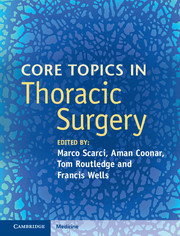Book contents
- Frontmatter
- Contents
- List of contributors
- Section I Diagnostic work-up of the thoracic surgery patient
- Section II Upper airway
- Section III Benign conditions of the lung
- 7 Congenital and developmental lung malformations
- 8 Lung volume reduction surgery for the treatment of advanced emphysema
- 9 Surgical aspects of infectious conditions of the lung
- 10 Treatment of haemoptysis
- Section IV Malignant conditions of the lung
- Section V Diseases of the pleura
- Section VI Diseases of the chest wall and diaphragm
- Section VII Disorders of the esophagus
- Section VIII Other topics
- Index
- References
10 - Treatment of haemoptysis
from Section III - Benign conditions of the lung
Published online by Cambridge University Press: 05 September 2016
- Frontmatter
- Contents
- List of contributors
- Section I Diagnostic work-up of the thoracic surgery patient
- Section II Upper airway
- Section III Benign conditions of the lung
- 7 Congenital and developmental lung malformations
- 8 Lung volume reduction surgery for the treatment of advanced emphysema
- 9 Surgical aspects of infectious conditions of the lung
- 10 Treatment of haemoptysis
- Section IV Malignant conditions of the lung
- Section V Diseases of the pleura
- Section VI Diseases of the chest wall and diaphragm
- Section VII Disorders of the esophagus
- Section VIII Other topics
- Index
- References
Summary
Introduction
Haemoptysis is defined as coughing up blood or bloody sputum from the airways. It is a relatively common presenting symptom in clinical practice. The symptoms can range from small volume specks mixed in with sputum through to massive life-threatening haemoptysis. It can be difficult to accurately quantify the volume of haemoptysis, as this mostly relies on patients’ subjective recollections, often in moments of high stress. In the clinical setting, the degree of compromise depends on the underlying cause, the patient's current health status and co-morbidities. There is no absolute volumetric definition of massive haemoptysis, with quoted volumes ranging from 100 ml to 1000 ml over 24 hours. In general 200–600 ml in 24 hours appears to be an acceptable definition for massive haemoptysis. A functional definition can also be useful to account for physiological effect of haemoptysis.
Massive haemoptysis is rare but a potential life-threatening emergency, which carries a mortality rate of up to 38%. It is estimated that 400 ml of blood in the alveolar space is sufficient to inhibit gaseous exchange significantly. In cases of massive haemoptysis, death commonly occurs as a result of asphyxiation as opposed to exsanguination. The patient's current health status greatly predicts severity, morbidity and mortality. Identified independent predictors of mortality include chronic alcohol dependency, malignancy, aspergillosis, pulmonary artery involvement, infiltrates involving two quadrants or more on the admission radiograph and requirement for mechanical ventilation. Haemoptysis is associated with many conditions. It warrants prompt investigation, although a cause may never be found. This so-called idiopathic or cryptogenic haemoptysis is quoted to be responsible for 3–42% of cases and carries a better prognosis. Key elements of the history can often suggest an aetiology; investigations can be focused around this, and management should be directed at the underlying cause. Massive haemoptysis is a medical emergency where initial management will centre on resuscitation, especially airway protection. In this chapter, we will discuss common causes of haemoptysis. We will also discuss history and key investigatory algorithms before reviewing current medical, radiological and surgical management options.
Causes
Haemoptysis is caused by many conditions. A full list is summarized in Table 10.1. The commonest causes vary according to geography, ethnicity, socioeconomic status and age. They can be broadly divided into being associated with infection, neoplastic disease, airway disease, systemic disease, cardiovascular disease and coagulopathy.
- Type
- Chapter
- Information
- Core Topics in Thoracic Surgery , pp. 105 - 114Publisher: Cambridge University PressPrint publication year: 2016



